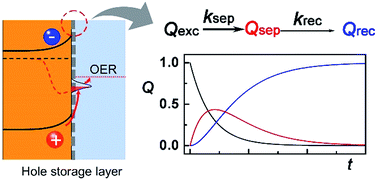当前位置:
X-MOL 学术
›
Chem. Sci.
›
论文详情
Our official English website, www.x-mol.net, welcomes your
feedback! (Note: you will need to create a separate account there.)
Ultrathin Fe-NiO nanosheets as catalytic charge reservoirs for a planar Mo-doped BiVO4 photoanode†
Chemical Science ( IF 7.6 ) Pub Date : 2018-09-19 00:00:00 , DOI: 10.1039/c8sc03297a Lei Li 1, 2, 3, 4, 5 , Xiaogang Yang 1, 2, 3, 4, 5 , Yan Lei 1, 2, 3, 4, 5 , Haili Yu 1, 2, 3, 4, 5 , Zhongzheng Yang 1, 2, 3, 4, 5 , Zhi Zheng 1, 2, 3, 4, 5 , Dunwei Wang 6, 7, 8, 9
Chemical Science ( IF 7.6 ) Pub Date : 2018-09-19 00:00:00 , DOI: 10.1039/c8sc03297a Lei Li 1, 2, 3, 4, 5 , Xiaogang Yang 1, 2, 3, 4, 5 , Yan Lei 1, 2, 3, 4, 5 , Haili Yu 1, 2, 3, 4, 5 , Zhongzheng Yang 1, 2, 3, 4, 5 , Zhi Zheng 1, 2, 3, 4, 5 , Dunwei Wang 6, 7, 8, 9
Affiliation

|
The energy conversion efficiency of a photoelectrochemical system is intimately connected to a number of processes, including light absorption, charge excitation, separation and transfer processes. Of these processes, the charge transfer rate at the electrode|electrolyte interface is the slowest and, hence, the rate-limiting step causing charge accumulation. Such an understanding underpins efforts focused on applying highly active electrocatalysts, which may contribute to the overall performance by augmenting surface charge accumulation, prolonging charge lifetime or facilitating charge transfer. How the overall effect depends on these individual possible mechanisms has been difficult to study previously. Aiming at advancing knowledge about this important interface, we applied first-order serial reactions to elucidate the charge excitation, separation and recombination kinetics on the semiconductor|electrocatalyst interfaces in air. The study platform for the present work was prepared using a two-step Mo-doped BiVO4 film modified with an ultrathin Fe-doped NiO nanosheet, which was derived from an Fe-doped α-Ni(OH)2 nanosheet by a convenient precipitation and ion-exchange method. The simulation results of the transient surface photovoltage (TSPV) data showed that the surface charge accumulation was significantly enhanced, even at an extremely low coverage (0.12–120 ppm) using ultra-thin Fe-NiO nanosheets. Interestingly, no improvement in the charge separation rate constants or reduction of recombination rate constants was observed under our experimental conditions. Instead, the ultra-thin Fe-NiO nanosheets served as a charge storage layer to facilitate the catalytic process for enhanced performance.
中文翻译:

超薄Fe-NiO纳米片作为平面Mo掺杂BiVO 4光阳极的催化电荷储存器†
光电化学系统的能量转换效率与许多过程密切相关,包括光吸收,电荷激发,分离和转移过程。在这些工序中,在电解质界面上的电荷转移速度最慢,因此成为引起电荷蓄积的限速步骤。这种理解为专注于应用高活性电催化剂的努力奠定了基础,这可以通过增加表面电荷积累,延长电荷寿命或促进电荷转移来为整体性能做出贡献。总体效果如何取决于这些单独的可能机制以前很难研究。为了进一步了解这一重要接口,我们应用了一阶串行反应来阐明电荷激发,空气中的半导体催化剂界面上的分离和复合动力学。使用两步掺杂Mo的BiVO制备了用于当前工作的研究平台用超薄的Fe掺杂的NiO纳米片改性的4薄膜,它是通过方便的沉淀和离子交换方法从Fe掺杂的α-Ni(OH) 2纳米片衍生而来的。瞬态表面光电压(TSPV)数据的模拟结果表明,使用超薄Fe-NiO纳米片即使在极低的覆盖率(0.12–120 ppm)下,表面电荷累积也显着增强。有趣的是,在我们的实验条件下,未观察到电荷分离速率常数的提高或重组速率常数的降低。取而代之的是,超薄的Fe-NiO纳米片充当电荷存储层,以促进催化过程以增强性能。
更新日期:2018-09-19
中文翻译:

超薄Fe-NiO纳米片作为平面Mo掺杂BiVO 4光阳极的催化电荷储存器†
光电化学系统的能量转换效率与许多过程密切相关,包括光吸收,电荷激发,分离和转移过程。在这些工序中,在电解质界面上的电荷转移速度最慢,因此成为引起电荷蓄积的限速步骤。这种理解为专注于应用高活性电催化剂的努力奠定了基础,这可以通过增加表面电荷积累,延长电荷寿命或促进电荷转移来为整体性能做出贡献。总体效果如何取决于这些单独的可能机制以前很难研究。为了进一步了解这一重要接口,我们应用了一阶串行反应来阐明电荷激发,空气中的半导体催化剂界面上的分离和复合动力学。使用两步掺杂Mo的BiVO制备了用于当前工作的研究平台用超薄的Fe掺杂的NiO纳米片改性的4薄膜,它是通过方便的沉淀和离子交换方法从Fe掺杂的α-Ni(OH) 2纳米片衍生而来的。瞬态表面光电压(TSPV)数据的模拟结果表明,使用超薄Fe-NiO纳米片即使在极低的覆盖率(0.12–120 ppm)下,表面电荷累积也显着增强。有趣的是,在我们的实验条件下,未观察到电荷分离速率常数的提高或重组速率常数的降低。取而代之的是,超薄的Fe-NiO纳米片充当电荷存储层,以促进催化过程以增强性能。









































 京公网安备 11010802027423号
京公网安备 11010802027423号